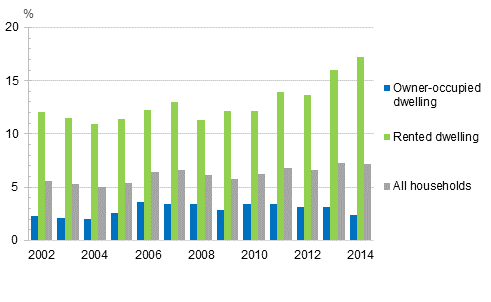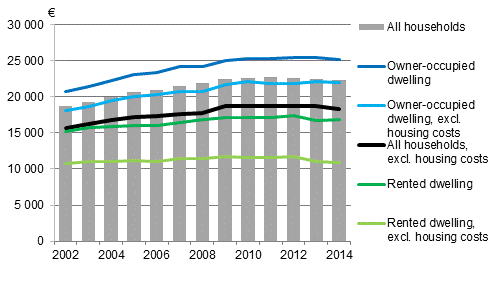Published: 8 April 2016
Number of households burdened by housing costs increasing among households living in rented dwellings
Households living in rented dwellings are more often burdened by large housing costs than households living in owner-occupied dwellings. Altogether, 17.2 per cent of the households living in rented dwellings were burdened by housing costs in 2014. The share was 1.2 percentage points higher than in 2013 and 3.6 percentage points higher than in 2012. These data derive from Statistics Finland’s income distribution statistics .
Households burdened by housing costs by form of tenure of the dwelling in 2002 to 2014, %

Households burdened by housing costs = the share of the household’s housing costs of the disposable monetary income, excluding housing allowances, is over 40 per cent.
In all, 17.2 per cent of households living in rented dwellings and clearly fewer, 2.4 per cent of households living in owner-occupied dwellings were burdened by housing costs in 2014. The number of households and persons burdened by housing costs living in rented dwellings started rising after 2011 again in 2013. Among households living in rented dwellings, 13.6 to 13.9 per cent were burdened by housing costs in 2011 to 2012, and in 2013 the share was around 16.0 per cent. In earlier years in the 2000s, the share of households burdened by housing costs among households living in rented dwellings had almost without exception remained at ten to twelve per cent (13.0% in 2007).
In 2014, a total of around 190,000 households were burdened by housing costs in the entire population and they comprised 254,000 persons. The share of households was the same as in the year before, 7.2 per cent.
The income differential between households by form of tenure of the dwelling remained almost unchanged in 2014 compared to 2013. The median for equivalent disposable income excluding housing costs decreased both for households living in rented and owner-occupied dwellings by around one per cent per consumption unit 1) in real terms. The income level before paying housing costs for households living in rented dwellings rose slightly (1.0%), by contrast, it declined for households living in owner-occupied dwellings (-1.3%) from the year before. Housing costs grew more for households living in rented dwellings than for those living in owner-occupied dwellings.
Household’s disposable monetary income per consumption unit by form of tenure of the dwelling in 2002 to 2014, median, at 2014 prices

In 2014, the median for equivalent disposable income of households or disposable income of households calculated per consumption unit was EUR 22,300 and excluding housing costs EUR 18,500. Households living in rented dwellings had an average disposable income (median) of EUR 16,900 and excluding housing costs EUR 10,900 per consumption unit. Households living in owner-occupied dwellings had more disposable income than households living in rented dwellings: on average (median), EUR 25,100 and excluding housing costs EUR 21,900 per consumption unit.
Since 2011, the income level of households has in general started weakening slightly. After paying the housing costs, the median for equivalent disposable income decreased for households living in rented dwellings by 6.3 per cent in real terms from 2011 to 2014. The income level of households living in owner-occupied dwellings remained almost unchanged (+0.3%). On the longer term, the income levels have differentiated more. From the beginning of the statistical reference period, from 2002 to 2014, the equivalent disposable monetary income before and after housing costs of households living in owner-occupied dwellings grew by around 21 per cent. Over the same period, the equivalent disposable monetary income of households living in rented dwellings grew by 11.1 per cent and by close on one per cent after subtracting housing costs.
1) Consumption units are based on the so-called OECD’s modified scale. One adult in the household is one consumption unit. Other persons in the household aged at least 14 are 0.5 consumption units each and children aged 0 to 13 are 0.3 consumption units each. A household with one adult member is one consumption unit, while a household consisting of spouses and one child aged under 14 together are 1.8 consumption units.
Source: Income distribution statistics 2014, Statistics Finland
Inquiries: Marie Reijo 029 551 2547
Director in charge: Jari Tarkoma
Publication in pdf-format (203.0 kB)
- Tables
-
Tables in databases
Pick the data you need into tables, view the data as graphs, or download the data for your use.
Updated 8.4.2016
Official Statistics of Finland (OSF):
Income distribution statistics [e-publication].
ISSN=1799-1331. Income, housing and housing expenditure 2014. Helsinki: Statistics Finland [referred: 16.4.2024].
Access method: http://www.stat.fi/til/tjt/2014/03/tjt_2014_03_2016-04-08_tie_001_en.html

